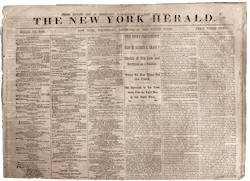February 5, 1861; The New York Herald
NAVY YARD, PENSACOLA, Fla., Jan. 14, 1861.
I propose giving to your readers a statement of facts in reference to recent events connected with the Navy Yard here and the forts that protect and command the entrance to this harbor. At such times as these facts that exhibit prominent political moves are interesting, even if they are not from the hand of a ready writer.
Upon the right hand of the entrance of the bay of Pensacola stands Fort Pickens; upon the left hand is Fort McRea, and upon the same shore with the latter, one mile and a quarter farther up the bay, is Fort Barrancas. These forts are nearly equidistant from each other, and so situated as completely to command the entrance to the harbor. Fort Pickens is an admirably constructed fortification, at the extremity of a long, narrow sand spit that separates the bay from the Gulf for some distance. This fort is so situated as really to command the entrance to the bay completely. It is approachable by land only along the narrow neck mentioned above, and its defences so arranged that even a small force may defend it against vastly superior numbers. Fort McRea is rather a dilapidated concern, but is, nevertheless, a strong water battery. Fort Barrancas is well built and a powerful defence of the entrance of the harbor, but neither its construction nor position is adapted to resist a strong land attack. These three large fortifications, with all their guns, ammunition, &c. were in charge of a single company of artillery, under the command at present, of Lieut. A. J. Slemmer. This company occupied the barracks near Fort Barrancas.
The Navy Yard is situated upon the same shore of the bay with Forts McRea and Barrancas, about one and a half mile above the latter. It was under the command of Commodore Jas. Armstrong; the next officer in rank at the yard was Commander Ebenezer Farrand. The disposable force at the Yard consisted of about seventy sailors, or ‘men,’as they are termed, and forty eight marines, under the command of Capt. Joseph Watson. There were also at the yard, subject to the commands of Commodore Armstrong, the United States storeship Supply, with two thirty pounders and thirty eight men, and the steamer Wynandot, with six thirty two and eight men. For a number of days rumors had been in circulation of an intention on the part of the authorities of Florida and Alabama to take possession of the Navy Yard and forts at this point. On the night of the 9th Lieutenant Slemmer stationed a guard at Fort Barancas. On the morning of the 10th he received orders from the War Department requiring him to use every means in his power to protect government property, and especially to keep the control over the entrance to the harbor. He was also informed at the same time that the commandant of the Navy Yard would be directed to cooperate with him.
On consultation with Com. Armstrong, and the promises of assistance from him, Lieut. Slemmer decided on removing at once into Fort Pickens, that post being the most tenable position and where he could more nearly obey the spirit of his orders. This matter being decided upon, the army officers went to work with a will and during the next twenty four hours had thrown their entire force with all their provisions, camp, equipage, &c. into the fort, and by the assistance of boats from the Supply and Wyandot, had removed the ammunition from Fort Barrancas to the magazines of Fort Pickens.
To what extent Com. Armstrong was ordered to cooperate with the army officers I do not know; but is a fair presumption that it was within the bounds of his power.
The Navy Yard itself is so situated that no military man would think of defending it against a large attacking force, with the means at the commodore’s command. In a military point of view, retaining possession of the Navy Yard was of small consequence, compared to a successful defence of the entrance of the harbor; and where it was necessary to make a choice the available force out by all means to have been concentrated in Fort Pickens. Taking this view of the case, and not thinking he was asking too much of the Commodore, Lieut. Slemmer urgently requested that the marines might be sent to assist his own company. The ‘men’ of the yard useless where they were, would also have been a not undesirable addition, and the two ships could have been so placed as to make their guns completely cover an enemy’ s advance by land. Lieutenant Slemmer asked in all good faith for this cooperation. Even after the Navy Yard was surrounded by armed men, and before it was taken, he wrote to the Commodore repeating his request that the marines might be sent him while there was yet time. This again met with no attention, and three hours later these men had all been taken prisoner, without having made even a show of resistance, and the brave little band already in Fort Pickens were left to their own resources.
